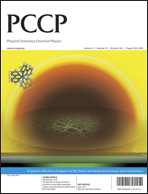Perturbation of solute transport at a liquid–liquid interface by polyethylene glycol (PEG): implications for PEG-induced biomembrane fusion†
Abstract
The effect of polyethylene glycol 400 (PEG) dissolved at various concentrations (0–40% v/v) in

- This article is part of the themed collection: Interfacial processes and mechanisms

 Please wait while we load your content...
Please wait while we load your content...